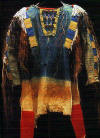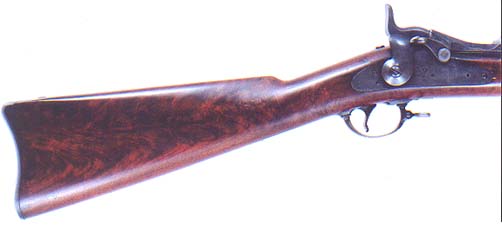
Plains warfare between various American Indian groups; and various European American groups was influenced and precluded by changes in technologies and military strategies in the Eastern Woodlands and Southwest from earlier colonial contacts of French, Dutch, English, Spanish and others from the late 1500's into the mid 1800's. Even during the peak conflicts (1851-1890) the American army tactics and techniques of warfare change, as well as the Plains cultures.
Warfare has many aspects and analysis begins with the reasons and goals humans propose for engaging in such futile and wasteful action. Tactics and Techniques are the terms military historians use to refer the methods of conducting war. It is generally accepted but not readily admitted that warfare is magnified and intensified in conjunction with the development of agriculture/civilization and further with industrialization. This created a contradiction when the term civilization is used since cultures became more violent with the never ending competition for resources as agriculture produced increased populations. In our own arrogance we see pre-industrial cultures as being inferior and less civilized; when in fact from the crucial perspective of human behavior and relationships contemporary culture is mired in cultural regression.
American Indian cultures of the Eastern Woodlands, Plains and Southwest had developed a more competitive agricultural lifestyle with intensification of warfare. Europeans by the 1600s were also agriculturalists but had moved more quickly in industrial pursuits of metal and gunpowder acquired from China. European warfare was certainly more organized and pervasive in the idea of conquest by destruction of property and slaughter of men, women and children. Certainly American Indians were equally ruthless but tended to conduct smaller scale raids and captured women and children for adoption to replace their own losses. Initial conflicts in the East and Southwest indicate that American Indians were impressed with firearms, metal, and horses; but that the bow and arrow had a greater rate of fire. It also was recognized by European Americans that disease was the more effective weapon for the removal of Indian populations. Further, the use of Indian mercenaries could be effective in tracking, guerilla warfare and even in conventional battles (e.g. Battle of Horseshoe Bend).
As both sides fought as allies or enemies, tactics and techniques changed as the gun began to be more effective. In the 1600s the matchlock and flintlock were rather inaccurate and had a slow rate of fire. From 1750-1840 the muzzle loading flintlock musket (smooth barrel) evolved to the much more accurate flintlock rifle (rifled/grooved barrel) that is sometimes referred to as the 'Kentucky Rifle'.

Pennsylvania/Kentucky Rifle
From about 1840-1851 the percussion breech loading rifle was common like the famous Hawkins Rifle which was effective in the slaughter of the Plain's Bison.
Just after the time the frontier that had jumped from St. Louis/ Independence, Missouri to the Far West via the Oregon Trail, California Trail, Immigrant Trail and Sante Fe Trail settlers began to covet land and resources in the Plains around 1850 the cartridge and breech loading weapons were developed such as early Spencer and Springfield rifles and carbines in the US. Plains tribes had acquired horses between 1650 and 1750, which they adapted in hunting and warfare. They had acquired early flintlock and percussion weapons but retained traditional weapons for back up and greater reliability. In fact Plains Indians kept up with the advancement of weapons and at certain times they had more modern weapons than the US Army.
 Springfield 45-70
Springfield 45-70
At the time of Red Cloud's War 1866-1868 early Henry and later Winchester repeating carbines and rifles came out. It was also clear that the small scale and individualistic tactic of counting coup by young warriors was no longer effective with the US Army sustaining a fire fight. The increased amount of ammunition that could be carried and fired contributed to this with the additional determination to drive the European American settlers out the Bozeman Trail area. This was an arrogant and aggressive violation of the Treaty of Ft. Laramie for Northern Plains Lakota (Sioux), Cheyenne and Arapaho and threatened some of the last existing northern herds of bison. Red Cloud (Lakota) began to sustain engagements and stop young men from going ahead to count coup and gain traditional honors. The Fetterman Fight (B. of the 100 Slain) was the best and most successful example of these changes.
Subsequent leaders like Crazy Horse continued these strategies during the Little Bighorn Campaigns. This led to the Battle of the Little Bighorn on June 25, 1876, in which George Armstrong Custer was defeated by a substantial force of Sioux and Cheyenne. In 1876 the Plains Indians had a substantial number of firearms including repeating Winchester rifles/carbines and Colt revolvers. The US Army was still equipped with the single shot Springfield rifle/carbine. For this short moment in history American Indians had the skill, will and technological edge that gave them victories. However, the US Army command knew that their best weapon was to destroy the life blood of the people, their food base, the bison. The humiliation of defeat gave uninhibited freedom for the US Army to launch a new winter campaign 1876-1877 that would bring in most of the people to the forts/reservations and drive some , like Sitting Bull, to Canada.
The later part of the 19th century (1880-) was limited to various acculturation policies to include reservations, boarding schools, allotment and missionaries. In 1890 some of the northern Plains people became so despondent that they tried to effect change through the Ghost Dance Movement. The US government Indian agent and military panicked and tried to suppress the movement which ended with the massacre at Wounded Knee on Dec 29, 1890. By this time smokeless cartridges and howitzers with explosive shells were part of the US armies issue weapons. The Lakota victims were poorly armed and this resulted in heavy casualties (300+), including women and children. Many of the soldier casualties were from their own crossfire, reflecting on the loss of control on the part of the 7th cavalry.